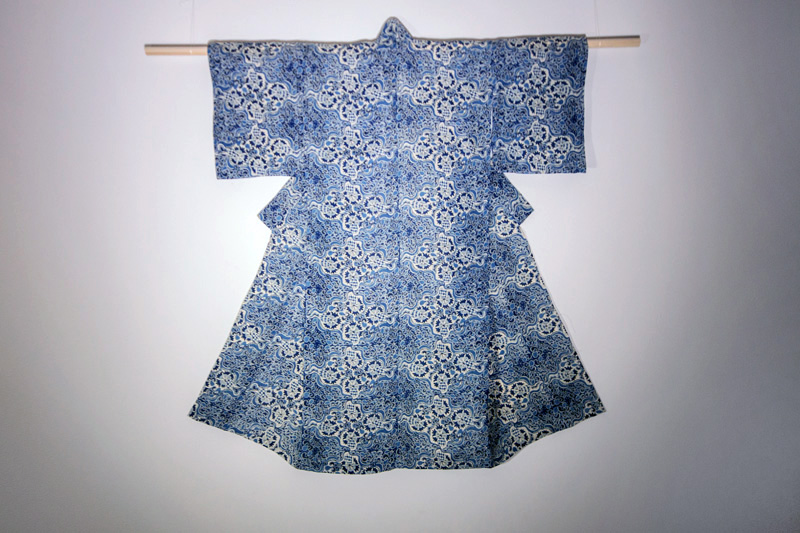About
日本語


I am interested in Japanese traditional folk textile dyeing from three perspectives:
- Strictly traditional. In this category I include those works where tradition dictates the technique and their utilization. For example, Kimono, Obi (kimono band), or Noren (Japanese curtain).
- Modern traditional. In this category I include those works where tradition dictates the technique of the work, while there is more freedom in its utilization. For example, tapestries and wall hangings.
- Post-modern traditional. In this category I include those works where tradition dictates the technique of the work, while the utilization breaks the traditional culture and serves new consumer demands. For example, “kimono remake” or traditional folk stencil-dyes adaptation for today`s life.

Resume
- Born in Madrid in 1955
- 1986 Integrated the Textile Dyeing Studio of Dote, in Ushiku-Japan
- 1986 Became a member of the Textile Dyeing network Moe Group, Ushiku – Ibaraki, Japan
- 1987 Textile dyeing accepted at the Komaba Museum of Japanese Folk Crafts Exhibition-New Works Exhibition-Komaba, Tokyo
- 1987 Group Exhibition, Tokyu Department Store, Nihonbashi, Tokyo
- 1988 Textile dyeing accepted Komaba Museum of Japanese Folk Crafts Exhibition, Komaba, Tokyo
- 1988 Group Exhibition “Dote Takehiko and his group”, Seiyu Department Store, Ushiku, Ibaraki
- 1988 Textile dyeing work selected at the National Exhibition in 1988, Ueno National Museum, Tokyo
- 1989 1 st Group Exhibition, Kawatoku Ichiban Kan Uchimaru ten Gallery, Morioka, Iwate, Japan
- 1989 Textile dyeing work selected at the National Exhibition in 1989, Ueno National Museum, Tokyo
- 1990 Textile dyeing work selected at the National Exhibition in 1990, Ueno National Museum, Tokyo
- 1990 2 nd Group Exhibition, Kawatoku Ichiban Kan Uchimaru ten Gallery, Morioka, Iwate, Japan
- 1991 3 rd Group Exhibition, Kawatoku Ichiban Kan Uchimaru ten Gallery, Morioka, Iwate, Japan
- 2001 Workshop introducing Stencil Dyeing (taught together with Mr and Mrs Dote) in Edinburgh during the Serizawa Keisuke Exposition, National Museums of Scotland.
- 2016 International Christian University, Tokyo. Research Student: Cultural Heritage - Traditional Japanese Crafts
- 2018 International Christian University, Tokyo. PhD candidate: Cultural heritage - Sustainability of Japanese Traditional Folk Textile Dyeing
- 2018 Tokushima, Kamiita city. Artist in Residence - Indigo dyeing. Tokushima, Japan
- 2020 Geneva Switzerland, Group Exposition at the WHO Art Gallery.
- 2020 Geneva Switzerland, Meet The Artist Series: Tradition and Authenticity - Japanese Folk Textiles Dyeing.
Traditional Japanese folk textile dyeing work includes kimono, kimono bands (obi), kimono coat (haori), and traditional curtain (noren); as well as tapestry and wall hangers.
Other art work includes book cover design, greeting cards, postcards, and other work on Japanese traditional paper (washi).
Current interest includes the adaptation of traditional Japanese textiles to modern needs (kimono-remake fashion; utilisation of dyed washi for interior design)
日本語
- 昭和30年にマドリードに生まれ
- 昭和61年土手型染工房
- 昭和61年萌えグループ
- 昭和62年駒場日本民藝館展 -新作工藝公募展-
- 昭和62年染展勉強会東急日本橋店東京
- 昭和63年駒場日本民藝館展 -新作工藝公募展-
- 昭和63年土手武彦と染の仲間展牛久型染研究会グループ萠
- 昭和63年国展入選(染色)
- 平成元年第一回染展もりおか:かわとく壱番館ギャラリー盛 岡岩手県
- 平成元年国展入選(染色)
- 平成2年国展入選(染色)
- 平成2年第二回染展もりおか:かわとく壱番館ギャラリー盛 岡岩手県
- 平成13年型染め紹介ワークショップ(土手夫妻とともに教えた)、エデインバラ、芹沢銈介展覧会中に、スコットランド国立美術館
- 平成3年第三回染展もりおか:かわとく壱番館ギャラリー盛 岡岩手県
- 平成28年国際基督教大学研究生(文化遺産, 「伝統的な日本 の工芸と外国人の社会統合」)
- 平成30年国際基督教大学博士過程入学(文化遺産「日本の文 化遺産のサステイナビリティ: 民芸としての染物の場合」)
- 平成30年とくしま上板熱中小学校で藍染のアーディストレシ デンス
- 令和2年 ジュネーブ スイス: WHO アートギャラリーでグループ展覧会
- 令和2年 ジュネーブ スイス: 「ア−テイストと会おう」シリーズ:伝統と正統性 ー 日本の民芸としての染物」
作品は型染め含め、着物、帯、羽織り、のれん、タペストリーなど である。
これに加え他の作品は本のカーバー、カード、絵葉書、わしや記事 学部染めなど。
現在の関心には、日本の伝統的なテキスタイルの現代のニーズへの 適応が含まれます(着物リメイクファッション、インテリアデザイ ンへの染色和紙の利用)
